Wemo
Latest
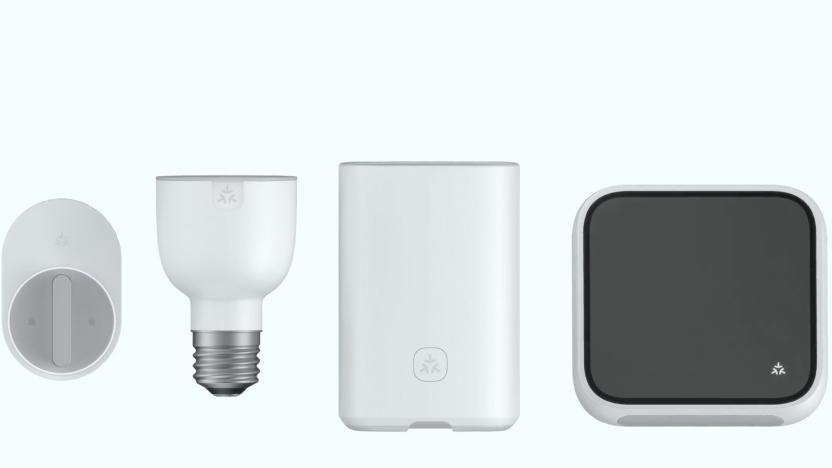
Samsung starts verifying Matter-compatible smart home devices
Samsung has started verifying some of the first smart home devices to support the new Matter standard.
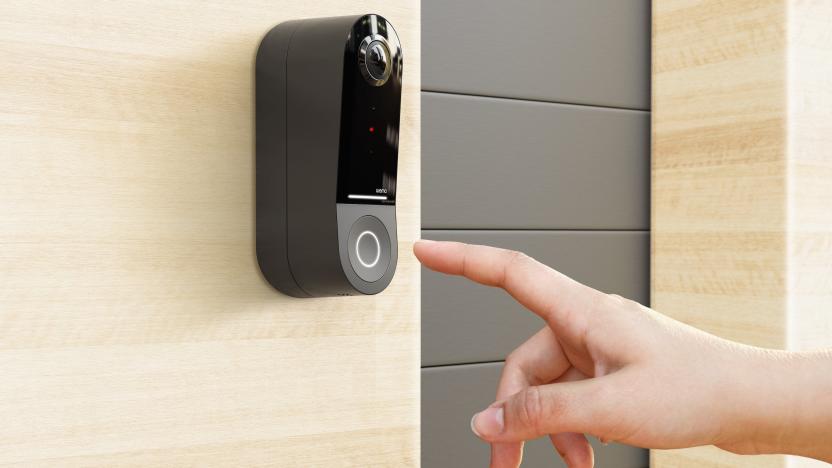
Wemo's Smart Video Doorbell is exclusive to the Apple ecosystem
It connects with HomeKit Secure Video on iPhone, iPad and Mac.
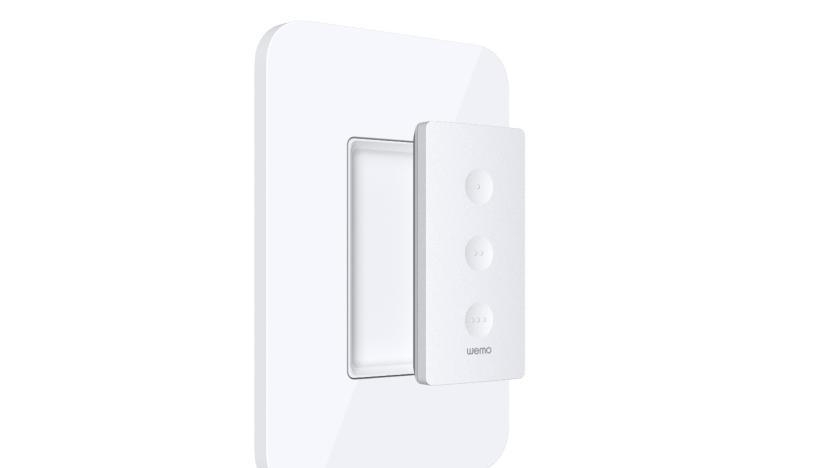
Wemo's latest smart home gadget is a $50 Apple Home remote
Belkin's new Wemo Stage Scene Controller can activate up to six different Apple Home scenes.

The best plug-in smart outlet
By Rachel Cericola This post was done in partnership with Wirecutter. When readers choose to buy Wirecutter's independently chosen editorial picks, Wirecutter and Engadget may earn affiliate commission. Read the full guide to plug-in smart outlets. A smart plug can make magic, turning any electronic device into one that can be controlled remotely or put on a schedule. That means you'll never have to enter a dark room or worry that you left the curling iron plugged in. We recommend the Wemo Mini, a reliable Wi-Fi smart plug that works with most major smart-home platforms, including Amazon Alexa, Apple HomeKit, and Google Assistant. The Wemo Mini is the only model that has been rock-solid reliable over long-term use, offers a compact design that won't block both outlets on a wall plate, and supports all the major voice-control platforms. Like most of the smart plug-in switches we tested, the Wemo Mini is easy to set up: Plug it into an outlet, download an app to your phone, make the wireless connection, and then control lamps, small appliances, and even higher-draw devices like fans and air conditioners. The Wemo family also includes light switches and dimmers, so it's easy to expand your system. The Lutron Caséta Smart Lighting Lamp Dimmer costs more than most smart plugs, but it has two outlets, allowing you to control two lamps or strings of lights at once (though not independently). And it lets you dim those lamps rather than just turning them on and off—a rarity among smart plugs. The Caséta system connects over a robust wireless mesh network, rather than Wi-Fi, so Wi-Fi dead spots in your house aren't a problem, but it requires Lutron's proprietary Caséta Smart Bridge hub. We recommend you buy a kit that includes the hub. This outlet supports only lamps, not fans or other motors, but the Caséta line includes compatible in-wall dimmers, window shades, and remotes, so this model is ideal for people who want a larger smart-home system. It works with Amazon Alexa, Apple HomeKit, Google Assistant, Nest, Samsung SmartThings, Wink, and more. The iClever IC-BS06 smart plug can weather the outdoors better than you can, with the best operating temperature (–4 to 140 degrees Fahrenheit) of any model we tested. It has two plugs you can control remotely and independently using the app or voice control (via Amazon Alexa and Google Assistant, but not Siri), and you can configure automations based on time, weather, humidity, temperature, air quality, sunrise and sunset, or triggers from other iClever devices. The TP-Link HS300 is a little pricier than the average smart plug, but it's worth it as it transforms one wall plug into six independently controlled outlets. Of the smart power strips we tested, it also has the most USB ports (three) and the longest power cord. It also supports voice control via Alexa, Google Assistant, Microsoft Cortana, and automations via IFTTT. The lowest priced model on our list is also the smallest—making it possible to fit the Monoprice Stitch Mini into almost any outlet in the house without crowding. It's also the least expensive model we've seen to include energy monitoring. Currently, it supports only Alexa and Google Assistant (and IFTTT unofficially), but you can also set schedules that are triggered by sunrise and sunset and local weather conditions.
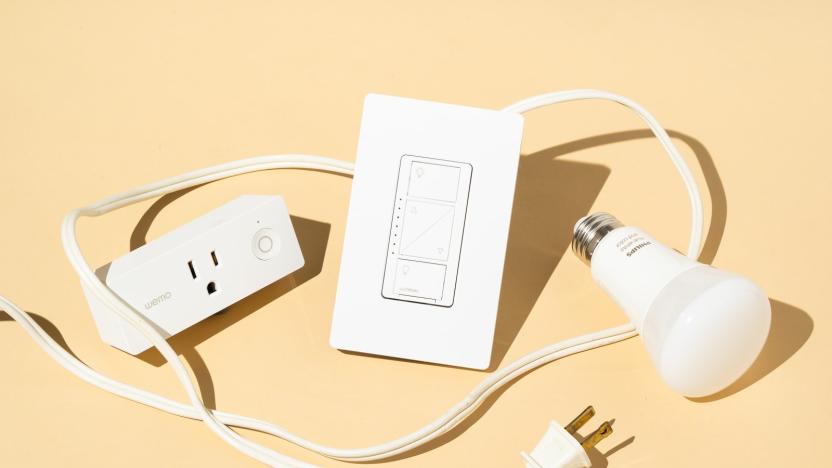
When to use a smart bulb, switch or plug
By Rachel Cericola This post was done in partnership with Wirecutter. When readers choose to buy Wirecutter's independently chosen editorial picks, Wirecutter and Engadget may earn affiliate commission. Read the full blog seeing the light: when to use a smart bulb, switch, or plug. I'm not sure if it's because I've captured a lot of critters on home security cameras or seen one too many horror movies, but entering a dark house terrifies me. Although my husband would be perfectly happy to solve this problem by leaving the lights on all day and night, it's completely unnecessary: Smart lighting exists for precisely this purpose. Setting up your home with smart lights can solve a lot of problems. However, because there are several types of devices you can pick from—bulbs, light switches, and add-on plugs—it can be hard to know where to start. Why and when do you pick one of those devices over another? All smart lighting devices allow you to control them from your smartphone, and you can set them up to work like old-fashioned lighting timers, but they can do much more. You can control whole groups of lights at once, set them to go on and off based on local sunset times, and configure them to respond to other smart devices, such as motion sensors or security cameras. But each type of device has a superpower (and also a weakness, just like Superman). Let's look at what devices work best for three different scenarios.
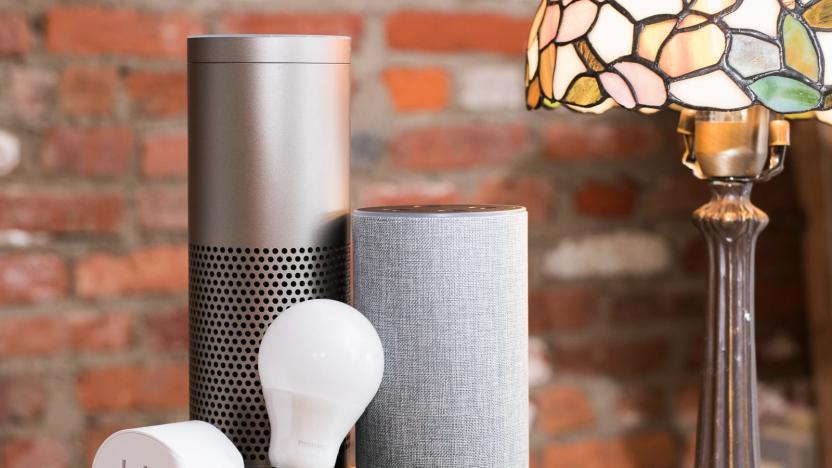
The best Alexa-compatible smart-home devices for Amazon Echo
By Rachel Cericola This post was done in partnership with Wirecutter. When readers choose to buy Wirecutter's independently chosen editorial picks, Wirecutter and Engadget may earn affiliate commission. Read the full guide to Alexa-compatible smart-home devices for Amazon Echo. Imagine walking into your home at night, arms overflowing with groceries. Even if you've installed smart lights, you'd need to put the bags down, pull out your phone, unlock it, open the app, find the control for the lights you want, and then tap the icon—might as well just stick with a plain old wired switch. But with an Alexa, you simply say, "Alexa, turn on the kitchen lights." And it's not just lights; Alexa is capable of controlling everything from basic smart plugs to garage doors. All three smart-speaker platforms (Alexa, Google Assistant, and to a lesser degree, Siri) can control a variety of smart-home devices and add an extra level of convenience to your smart-home system. We think Amazon's Alexa has a slight edge over the others because it works with more devices, and the wider family of Amazon Echo products makes it easier to fit them everyplace in your home. However, if you already have a Google Home speaker, the differences aren't large enough for you to need to switch platforms. We have guides for the best devices to use with Google Assistant and Siri/HomeKit. The Amazon Echo (or Echo Dot) offers a convenient interface for your smart home and provides functionality that an app on your phone can't. If you already have some Alexa-compatible devices or one of the three major smart-home hubs (SmartThings, Wink, or Insteon), adding an Echo can make accessing those devices more interesting and convenient. Taking advantage of its near-instantaneous response time and reliable voice-recognition processing is significantly faster than pulling out your phone and opening an app just to turn the lights on or off. Some products, such as Philips Hue lights and Nest thermostats, have native Alexa support, while others require you to enable a third-party skill. We tested plenty of both varieties to come up with the best-performing and most reliable recommendations, which we're continually testing to ensure that each new firmware and app update meets our high standards. Over the past several years, Wirecutter's editors and writers have tested just about every smart-home device of consequence. As more people end up buying smart speakers and platform support gets more and more important, we wanted to provide one place where you could access all of our picks that are compatible with the devices you already own, across all of our smart-home recommendations. Because these devices receive regular updates with additional compatibility and new features, we are continually testing and reevaluating our picks in our own homes to confirm that they still meet our recommendation standards. We'll update this guide as we learn new information, but be sure to read the full reviews if you'd like more details and test notes. If you don't yet have an Alexa-enabled device, or you want to learn more about what Alexa is and what you can do with these things, check out our full guide to Alexa and Amazon's Echo line of smart speakers.

Belkin's latest Wemo light switches work natively with HomeKit
Until now, using one of Belkin's Wemo Light Switches with Apple's HomeKit has meant attaching a bridge. No more: Belkin is introducing new Light Switches that take advantage of Apple's software-based authentication to offer native HomeKit support. In other words, you don't have to think much about your setup -- you can flick a switch and know that it'll turn on all the lights in your Home app rooms. This isn't completely novel (Philips added HomeKit support to the Hue Tap in 2017), but it's certainly helpful.
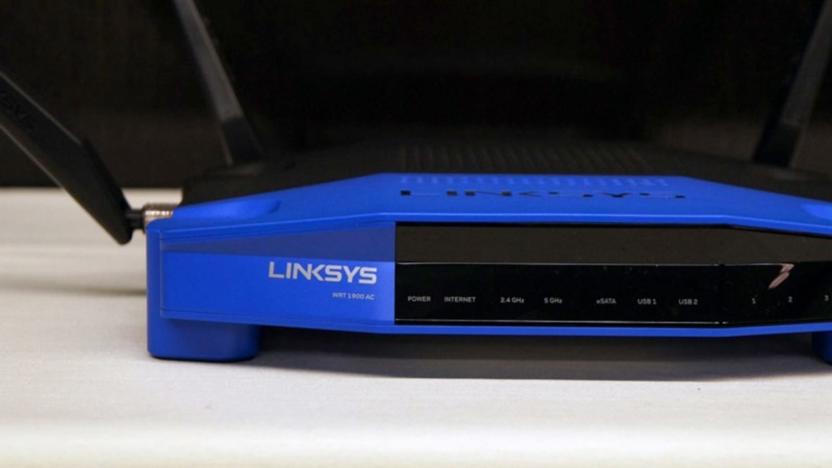
Foxconn buys Linksys owner Belkin to join the smart home battle
While we've focused on efforts of giants like Google, Apple and Amazon to dominate "smart home" devices, manufacturing giant Foxconn is making its entry by acquiring Belkin International to create a "global consumer electronics leader." Besides the accessories you probably associate with Belkin, it also owns other brands like WeMo, Phyn and, most notably, Linksys, which it acquired from Cisco in 2013. Every one of these internet-connected devices will need to plug into the router at some point, so it's easy to see why Foxconn would want to start there. The $866 million purchase is, however, subject to approval from the Committee on Foreign Investment in the United States. After Broadcomm was forced to give up its attempted Qualcomm acquisition, it's impossible to be certain if this deal will go through.

Siri will soon control Belkin's WeMo smart switches
WeMo, Belkin's line of smart light switches and plugs, will soon be compatible with Apple's HomeKit. Its products already give you a way to control the electronics in your home wherever you are, but HomeKit support means you'll be able to ask Siri to do it for you. You can, for instance, tell virtual assistant to "dim the lights in the living room" or switch them on or off completely. That said, you'll have to do more than update your software or download an app to get that feature. You'll have to get WeMo's upcoming HomeKit-enabled device called Bridge to be able to ask Siri on your iPhone, iPad or Apple Watch to control supported devices.

Use Google Home to control WeMo and Honeywell connected devices
Since Home arrived a few months ago, Google has been regularly adding new features to the compact speaker and its virtual assistant. Today, the company announced that the connected device can now be used to control smart home gadgets from Belkin's WeMo line and Honeywell. This adds more options for controlling lights, switches, thermostats and more with a simple "Ok Google" voice command.

WeMo's smart home upgrades include a dimmer switch
Belkin is continuing its quest to cover virtually every aspect of your smart home. Its WeMo brand is kicking off CES with two devices that promise to be handy even for those devices that don't have any intelligence of their own. The centerpiece is the WeMo Dimmer, a light switch that promises more than just extra control over your brightness levels. You can calibrate it to work with any light bulb type, for instance -- you'll get the best possible range of light levels without worrying about flickering or noise. There's also nighttime mode scheduling to avoid blinding yourself, long-presses to control other WeMo devices and an away mode to pretend you aren't on vacation.
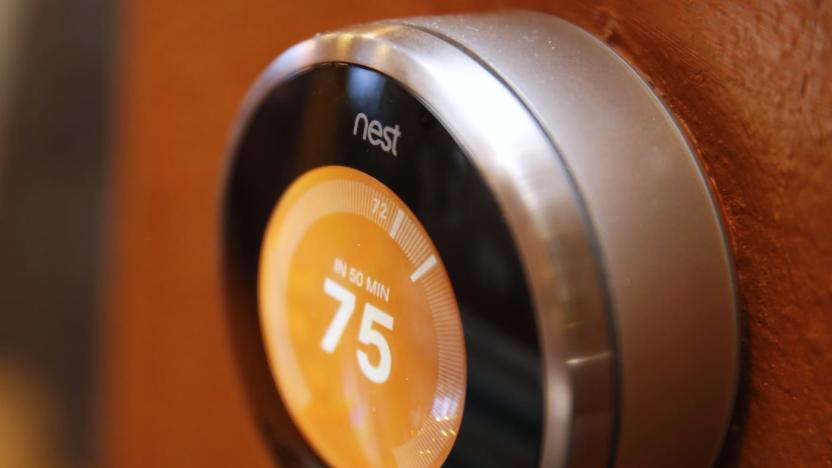
Nest's thermostat now talks to WeMo smart home switches
Want Nest's smart thermostat to do a lot more than change the temperature when you're out? Belkin is about to make your day. The gadget maker has introduced Works with Nest support to its WeMo switches and the WeMo Maker, giving you an easy way to toggle devices when you're home or away. You can switch on the lights when you get home, for example, or turn on a fan to cool down your home while you're out. The WeMo app has control over the Nest thermostat's target temperature, too, in case you'd rather not switch apps. All the integration support will be live the moment the latest WeMo app update arrives (no later than 3PM today, the 17th), so you don't have to wait long to automate more of your household.

Amazon Echo controls Belkin WeMo and Philips Hue with your voice
Amazon's voice-controlled speaker just became a lot more useful. In an email to Echo owners, the online retailer revealed some Philips Hue and Belkin WeMo gadgets can now be paired with the audio device. This means that the unit's ability to accept your spoken commands extends to home automation tech -- in addition to its music duties. Once the whole lot is connected to your home WiFi, a simple "discover my appliances" will automatically pair them. From there, dimming the lights, turning on the coffee pot and more is a matter of uttering the proper phrase. For now, supported products include Philips Hue A19, Lux, BR30, Bloom, and LightStrip as well as Belkin WeMo Switch, Insight Switch and Light Switch. If the added features convinced you to splurge for one, you'll have to wait in line. You can request an invite to order the $200 speaker, but it'll take several weeks to hit your inbox.

BeeWi takes on Belkin's WeMo with its new home automation platform
Not surprisingly, the Internet of Things is making a big splash here at CES 2015. As part of that push, BeeWi, a company better known for making various wireless products, is showing off its home automation platform. The BeeWi platform has been available in Europe, Canada and parts of South America for some time now, but the company announced that it's ready to bring it over to the US. In similar fashion to Belkin's WeMo line, BeeWi's home automation offerings include a mobile application and an array of modular sensors and trackers.

Belkin's WeMo home sensors track everything and the kitchen sink
Do you want to know every little nuance of what's going on in your home? You'll want to give Belkin's new WeMo home sensors a look, then. The surprisingly wide range of household trackers includes a door-and-window sensor, a keychain tracker, a motion detector and a water efficiency monitor -- there's even an alarm sensor that listens for sounds from other sensors, like smoke detectors. All of the devices will alert you if something's amiss, whether you're worried about intruders or tend to run the kitchen faucet for too long. And like the rest of Belkin's highly modular WeMo hardware, they'll frequently work in tandem with other gadgets on the platform. They can turn on the lights when you step into a room, or ramp up the air conditioning only when your window is closed. Most of the sensors will arrive in the second half of 2015, with pricing coming later. The water sensor is still in field testing, however, so it won't be ready to analyze your plumbing until the tail end of the year.

WeMo Maker brings the fun of experimentation to iOS
Belkin's WeMo line of connected devices has been around for a few years now, and I've had fun fiddling around with the various switches, wall outlets, motion sensors, and light bulbs that are part of the line. More recently, I've had the pleasure of using the free WeMo app to test out remote control of the new Crock-Pot Smart Slow Cooker and Mr. Coffee 10-Cup Smart Optimal Brew Coffeemaker. Both of those appliances use WeMo connectivity to let you turn the devices on or off, make changes to cooking or brewing, and even set up a schedule to start cooking or brewing. The one thing that was missing was a way to just play around with connecting other devices and sensors to the WeMo world. Enter WeMo Maker (US$79.99), a new entry to the WeMo family that opens the door to inventors and others who want to experiment with connected devices. The device is deceptively simple: it's a 3 by 3 by 1.5 inch box with an adjustable 3.5 inch antenna on top. The front is dominated by a large pushbutton, the back features a power cycle button, a restore button for resetting to factory default settings, a power light and a "relay" light. But it's the connection blocks on the bottom of the device that make the big difference. One is marked "Relay" and features two connectors, while the other is marked "Sensor" and features three connectors. The relay can be used to mimic a momentary or toggle switch. The momentary switch can be used in those situations where you need to mimic punching a button. Think of the wired button for a garage door opener - you punch the button, which sends a momentary signal to the opener to either open or close the door depending on its current state. The toggle switch, on the other hand, could be used to turn on a heater until a temperature setting is reached, at which time it is turned off. That garage door example? It just happens to be what I'm going to use the WeMo Maker for, since I have a really old garage door opener that could use a bit of Internet connectivity. How about the sensor connector block? Well, just about any 5V digital sensor can be used with it. I bought a cheap ($3.50) magnetic switch sensor from Adafruit that I'll use to determine whether my garage door is open or closed, but I could just as easily have purchased a visual sensor of some sort. WeMo Maker is controlled by the free WeMo app, which sees the Maker and adds it to a device list. Editing the device, you can change its name, add a picture, set the type of switch (momentary or toggle), and tell the app whether or not a sensor is attached. Back in the monitor/control view of the app, you'll see a button allowing you to trigger the relay as well as a "subtitle" that shows whether or not the sensor has been triggered. In my example, tapping the button would let the relay send a momentary signal to the garage door opener to open or close the door, while showing the sensor as "triggered" would tell me that the door is currently open. The WeMo Maker itself requires power; the company thoughtfully provides a USB to micro-USB cable with a USB-out AC plug, as well as a 3-foot cable. As for the wires connecting the Maker and the garage door opener? Well, I had to find my own. My choice probably wouldn't pass muster with a electrician, but since the relay sends out low voltage and amperage, I probably can't get into too much trouble, right? Sure enough, after attaching the relay leads to the two screw contacts on the garage door opener, plugging the Maker in and then letting it "find" the Wi-Fi network, I was able to tap the "Garage Door Opener" button in the WeMo app and open the garage door. Success! The remainder of the installation involved mounting the WeMo Maker with a pair of screws so that it wasn't just dangling from the garage ceiling outlet and connecting the sensor in such a way that it can tell me via the app whether my garage door is opened or closed. What's my next step? Well, there's a WeMo Maker Channel in IFTTT, meaning that I can start writing recipes that can do some really cool things. For example, I can write a recipe to have IFTTT check to see if the garage door is open at 10 PM at night (when it should be closed) and if it is, close the door. Or I could write a recipe for opening the garage door when I'm within a certain geofence. I'm not an "inventor" or electronics whiz by any stretch of the imagination, which is why I find the WeMo Maker to be so useful. If you already have a few WeMo devices but want to play with hooking up something other than lamps and appliances, you owe it to yourself to buy WeMo Maker.
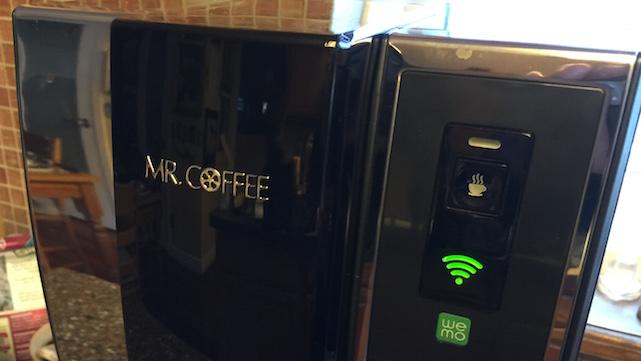
Mr. iPhone, meet Mr. Coffee
You know what's been missing in our lives? An Internet-connected, app-controlled coffeemaker. And that's why the good folks at Belkin and appliance manufacturer Jarden Corporation have teamed up to bring the world the Mr. Coffee 10-cup Smart Optimal Brew Coffeemaker with WeMo (US$149.99). To learn more about how your sad, depressing life can now be filled with happiness and freshly-brewed coffee, read on. Design Like the other Jarden/WeMo collaboration - the Crock-Pot Smart Slow Cooker with WeMo - the Mr. Coffee Smart Coffeemaker dispenses with fancy displays, replacing them with integration with the free WeMo app. The device looks a lot like a standard coffeemaker, featuring a large thermal carafe as well as the usual water tank and filter/grounds basket. But there are some technological differences that are not immediately apparent to the naked eye. First, the water tank is removable so you can put it under the faucet for filling. I love this idea, since my existing coffeemaker requires me to fill the carafe with water, then pour it into the tank - that usually means that I end up spilling at least a half-cup or two of water, even when I'm careful. The next difference has to do with the Optimal Brew technology, which heats water up to 205°F before sending it to the filter basket. According to the Mr. Coffee folks, this means that it not only extracts the most flavor from the ground coffee, but you can get a full pot of coffee in just under eight minutes. That's 20 percent faster than most competing thermal carafe-type coffeemakers. The Mr. Coffee Smart Coffeemaker should also be more energy efficient than those that don't use a thermal carafe, since it doesn't need to run a heating coil for a few hours each day to keep the brewed coffee warm. Functionality To test the Mr. Coffee Smart Coffeemaker, well, I made a pot of coffee - two, actually. It's a piece of cake to get ready to make a pot; you just fill the removable reservoir and then drop it into the appropriate place, then pull out the drawer for the filter basket and fill the basket with ground coffee. If you just want to make a pot of coffee, there's a button you can push and you'll have your steaming brew about 8 minutes later. The app comes in when you decide you want to set up a schedule. The app is the standard WeMo app, and setting up the coffeemaker for app control is easy. When you first power up the coffeemaker, it sets up a WeMo Coffeemaker Wi-Fi network. Attach your iPhone to that network, pull up the WeMo app, and it finds the coffeemaker. Within seconds the app sets up the coffeemaker so that it's working on your usual Wi-Fi network. The app can be used to simply "press the button" remotely, which would be useful if you were about to take a shower or something and wanted a pot of fresh coffee when you were done. It can also be used to set up a brewing schedule for each day. Setting up the schedule is similar to setting an alarm in the iOS Clock app. You tap on a day, then use a time picker to set the time. Tap "Save Schedule", and the schedule is saved to the device. If you haven't put coffee and water into the device, it senses that there's no water (there is no sensor for the coffee bin that I can tell) and will tell you to "Refill Water". Once you've filled up the tank and refresh the app, it shows that it's "ready". When the pot of coffee starts brewing, the app tells you that it is doing so by showing the word "brewing" and displaying an animated green cup of coffee. After brewing is done, refreshing the app shows a green "hot cup of coffee" icon and lists the time that the pot finished brewing. If there's one thing I'd like to see the app or device do is actually send me a notification that the coffee is ready to drink. You do get notifications when the water filter -- which lasts for a month -- needs to be replaced. While testing, I left a pot of water that had gone through the coffeemaker in the thermal carafe overnight. To my amazement, it was actually still warm over twelve hours later. In terms of the taste of the coffee, I felt it was a bit more "overextracted" and bitter than what I'm used to with my regular coffeemaker. You may need to play with the amount of coffee used in the basket to get the best possible flavor. Price-wise, the addition of the WeMo capability adds $60. The non-WeMo version of the Optimal Brew 10-cup Thermal Coffeemaker has a suggested retail price of $89.99, while this version runs $149.99. Whether that $60 is worth the convenience of being able to start a brewing cycle from anywhere in your house or change your coffeemaking schedule from your iPhone is entirely up to you. Unlike some other WeMo-enabled devices, there's no way at this point to integrate the Mr. Coffee Smart Coffeemaker with other devices through IFTTT. I can see where it could be very useful to have the coffeemaker automatically start brewing when you enter a certain geolocation (like when you get near your office), and that's either going to take IFTTT integration or location awareness on behalf of the WeMo app. What I'd really like to see down the road is a more complete connected coffeemaker that connects to a water supply and has large built-in bins for beans and used grounds so you wouldn't even have to touch the device for a week or two in regular home use. That device would also probably be out of my price range, but it would be impressive... Conclusion Belkin's WeMo family of connected devices continues to grow with the addition of smart appliances to the mix, and all of them are easily controlled from one single iPhone app. The Mr. Coffee 10-cup Smart Optimal Brew Coffeemaker with WeMo adds the convenience of WeMo to a trusted, longtime appliance brand. If you're a fan of connected devices, this coffeemaker does a good job of letting you schedule and monitor brewing from your iPhone. It will become even more useful if Belkin adds IFTTT integration and better notification to the mix. Rating: 3-1/2 stars out of 4 stars possible

Belkin and Mr. Coffee want to brew your first pot via WiFi
Belkin is no stranger to home automation, introducing several products in that vein through its WeMo line. We already put the company's Crock-Pot through its paces, and now there's a WiFi-enabled coffee option, too. The Mr. Coffee smart coffee maker brews 10 cups of joe, controlled from the handy WeMo app on a phone or tablet. Using the mobile software, you can schedule brewing, monitor its status, turn the unit off/on and get alerts when it's time for a proper cleaning. It also boasts Optimal Brew tech that's said to brew faster while packing in more flavor (we'll be the judge of that). If you're itchin' to get the coffee going before you roll out of bed in the morning, the $150 kitchen gadget is available now. Of course, if money's no object, and you have serious caffeine habit, there's a semi-automated pour-over option that we're a bit fond of.

Belkin Crock-Pot Smart Slow Cooker review: Can WiFi make cooking easier?
Frying, baking, grilling, searing, boiling, roasting -- whatever the method, I love to cook. It's not always easy, and sometimes it's just plain hard work, but at least it's the kind of work I enjoy. Even so, I've never used a slow cooker, and have always been a little jealous of my friends who have one. Put ingredients in and deliciousness comes out. It seems so easy! Since I hadn't yet run out to my nearest Target to add a slow cooker to my kitchen collection, I jumped at the chance to try the Belkin Crock-Pot Smart Slow Cooker with WeMo. The name is a bit of a mouthful, but the idea of a slow cooker I could monitor remotely seemed like a definite plus -- using it to check on the things I cook and making adjustments as needed. And in this case, I could do it from my phone, even while riding on the train or walking to my apartment. Convenient!

How to get started with home automation through Z-Wave
For many of us, smart homes seem like a far off concept from a science fiction novel set hundreds of years in the future. Imagine things like appliances that learn our schedules, lights that turn off after we leave a room, locks that can be remotely triggered to let yourself (or others) into your house and more. You know what though? The future is here. Engadget reader Dignan17 shows us what it takes to get started with home automation using Z-Wave compatible devices.









